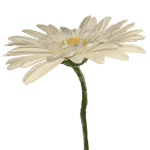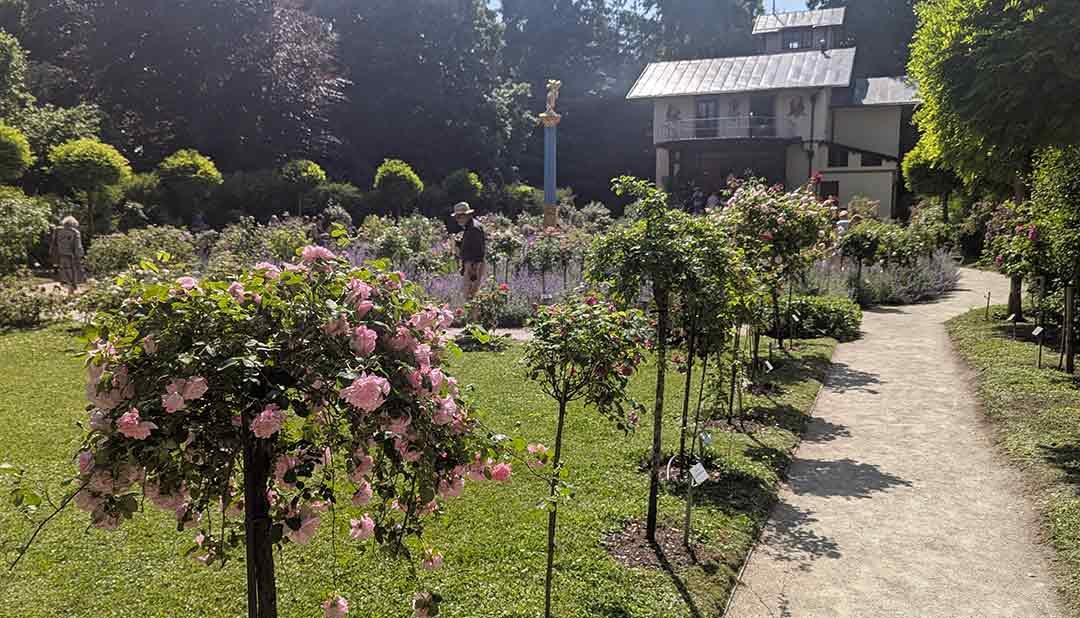A visit to the prime spot for weddings revealed that the art of standard rose pruning appears to have been perfected on this rose island
The circular rosarium on the rose island at the Lake Starnberg near Munich in Germany has been developed over centuries and it now showcases a significant collection of historical roses, featuring numerous varieties expertly trained as high-stemmed (standard) forms, alongside traditional shrub roses, all contributing to its historical garden ambiance.
Because a lot of the rose varieties have French botanical names I wondered how much Josephine Bonaparte had an influence in breeding them and which of these are likely to have been included in her rose collection at Malmaison.
Joséphine’s collection flourished between 1804 and 1814 (her death). She aimed to collect every known variety of rose, and her patronage greatly stimulated French hybridizers. Her garden contained an impressive diversity, including 167 Gallicas, 27 Centifolias, 22 Chinas, 9 Damasks, and 8 Albas (web search).
Standard Tree Roses:
These varieties are grafted onto tall rootstocks to create an elevated “tree-like” form. This training highlights their blooms at eye level and adds vertical interest to the garden. The resulting head can be a classic lollipop, a more informal bush, or a cascading “weeping” shape, depending on the rose’s natural growth habit.
Portland Roses: Known for their compact, bushy growth, strong fragrance, and good repeat-flowering habit, making them excellent choices for classic standard forms.
- ‘Mme. Boll’ (1850) – A highly fragrant, rich pink rose with a classic Old Rose form. Its dense, bushy growth is ideal for a standard head.
- ‘Mme. Knorr’ (1855) – Another intensely fragrant, vibrant pink Portland, similar in form and excellent for repeated flushes of bloom on a standard.
- Hybrid Perpetuals: A crucial class in rose history, known for their large, often very fragrant flowers and their ability to rebloom (perpetual flowering). Many have a robust, upright growth habit suitable for standards.
- ‘Reine des Violettes’ (1860) – Renowned for its unique, velvety dark violet-purple, highly fragrant blooms that fade gracefully. As a standard, it offers a stunning color accent.
- ‘Ulrich Brunner Fils’ (1881) – A vigorous rose with large, cup-shaped, cherry-red blooms that are very fragrant. Its strong, upright growth makes it a commanding and classic standard rose.
Bourbon Roses: An important class originating from the Île Bourbon, known for their full, fragrant flowers and good repeat-flowering, often forming large shrubs or short climbers.
- ‘Province Panachée’ (exact introduction date often varies, sometimes confused with others like ‘Honorine de Brabant’) – This beautiful, striped Bourbon rose typically displays petals variegated with shades of pink, white, and sometimes purple streaks. As a standard, it creates a unique and eye-catching display.
- Noisette Rose: The first class of repeat-flowering climbing roses, originating in the USA. They are known for their clusters of relatively small, often fragrant flowers.
- ‘Blush Noisette’ (1817) – A very old and popular Noisette that forms a graceful, arching shrub or short climber. As a standard, it produces abundant clusters of small, very fragrant, pale pink to blush-white flowers continuously throughout the season, creating a soft, cloud-like effect.
Damask Rose: An ancient class, highly prized for its intense, classic “old rose” fragrance, particularly the autumn-flowering varieties.
- ‘Damaszener Rose ‘Dopaphan’ 1832′ (Often listed as ‘Dupont’ or ‘Dupontii’) – A highly fragrant Damask with large, semi-double, pale pink to white blooms. Its presence as a standard allows its exceptional scent and delicate beauty to be appreciated at nose height.
Climbing Roses (Ramblers): These roses have long, flexible canes. When trained as standards, they create a dramatic “weeping” or cascading effect, where the canes trail downwards from the graft point.
- ‘Veilchenblau’ (1909) – A popular, nearly thornless rambler, celebrated for its spectacular clusters of small, intensely fragrant, violet-purple flowers that fade to slate-blue. As a standard, it forms a breathtaking, weeping dome of color in early summer.
- ‘Albéric Barbier’ (1900) – A vigorous, nearly evergreen rambler with glossy, dark green foliage and clusters of creamy white, semi-double, fragrant flowers. Trained as a standard, it creates a large, elegant, cascading mound that is disease-resistant and attractive even out of bloom.
Gallica Rose: One of the oldest cultivated rose classes, known for their vibrant, often rich and varied colors (including stripes), and strong fragrance. They are typically once-flowering shrub roses.
- ‘Rosa gallica ‘Versicolor” (syn. ‘Rosa Mundi’) – A very famous and historically significant Gallica, renowned for its striking semi-double blooms that are streaked and splashed with crimson, pink, and white. As a standard, its unique, painterly flowers are showcased prominently.
Other Historical Roses (Shrub Form):
These varieties are traditionally grown as free-standing bushes or large shrubs, forming the backbone of the garden’s historical accuracy and beauty.
- Centifolia Roses (Cabbage Roses): This class is a cornerstone of historical rose gardens, celebrated for their many tightly packed petals forming a “cabbage-like” bloom, and their intense, sweet fragrance. They are generally once-flowering.
- Represented by 1,000 plants in the circular bed. Examples of varieties that are likely present include:
These roses are cherished for their historical significance, fragrance, and lush blooms. If you visit in summer, you’ll experience them at their peak! You can find more details on and the .
What are the unique characteristics of each variety?
Gallica Rose:
- ‘Sissinghurst’ (Discovered before 1947, also known as ‘Rose des Maures’) – A compact and healthy shrub with uniquely dark, velvety plum-crimson, semi-double, fragrant flowers. It is once-blooming and highly valued for its intense color and historical connection.

